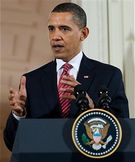 The waiting will soon be over. Later today, the President Obama is expected to order around 34,000 troops into battle, including into Helmand province. This surge will be added to the additional 500 troops Gordon Brown committed yesterday and what sources tell me are cast-iron troop offers by another eight countries, including Turkey, Australia, Montenegro, and Georgia.
The waiting will soon be over. Later today, the President Obama is expected to order around 34,000 troops into battle, including into Helmand province. This surge will be added to the additional 500 troops Gordon Brown committed yesterday and what sources tell me are cast-iron troop offers by another eight countries, including Turkey, Australia, Montenegro, and Georgia.
If all these countries do sign up to send more troops, the credit must primarily go to Anders Fogh Rasmussen, the NATO Secretary-General, who has travelled far and wide in the attempt to drum up more military muscle. No doubt Gordon Brown will claim that his two week effort was key in securing the extra troops – but, while I would not want to cast aspersions on the PM’s diplomatic skills, I suspect any non-US surge will have been the result of the Dane’s tireless lobbying.
Even if these countries sign up, however, problems remain. Besides Turkey and Australia, many of the likely troop-contributing states are small and bring little military oomph. Donald Rumsfeld found out in Iraq how useless it is to rally a coalition of which counts Vanutu, Georgia and Samoa on par with Britain, Italy and the Netherlands. The chart shows how many countries are currently supporting ISAF – and how few have sent large contingents.

A bigger concern is how the surging NATO troops will manage to pair up with and train the Afghan forces. The ANA is authorised to reach 134,000 personnel by Oct 2010. This month the ANA’s actual strength was approximately 94,000. But only 3-4,000 of these are in Helmand. And with seventy percent incapable of conducting independent operations, only about 1,200 are able to fight the Taliban. That is a very low number, after eight years of building the ANA and four years of operating in Helmand.






Comments